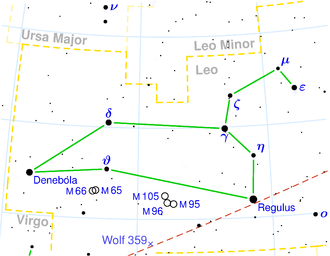NGC 3419
| Galaxy NGC 3419 |
|
|---|---|

|
|
| SDSS | |
| AladinLite | |
| Constellation | lion |
|
Position equinox : J2000.0 , epoch : J2000.0 |
|
| Right ascension | 10 h 51 m 17.7 s |
| declination | + 13 ° 56 ′ 46 ″ |
| Appearance | |
| Morphological type | (R) SAB (r) 0 + |
| Brightness (visual) | 12.9 mag |
| Brightness (B-band) | 13.8 mag |
| Angular expansion | 1.2 ′ × 1 ′ |
| Position angle | 115 ° |
| Surface brightness | 12.9 mag / arcmin² |
| Physical data | |
| Affiliation | LGG 216 |
| Redshift | 0.010124 ± 0.000023 |
| Radial velocity | 3035 ± 7 km / s |
|
Stroke distance v rad / H 0 |
(131 ± 9) · 10 6 ly (40.3 ± 2.8) Mpc |
| history | |
| discovery | Albert Marth |
| Discovery date | April 1, 1864 |
| Catalog names | |
| NGC 3419 • UGC 5964 • PGC 32535 • CGCG 066-041 • MCG + 02-28-018 • 2MASX J10511773 + 1356457 • GALEX ASC J105117.79 + 135645.5 • USGC U327 NED02 | |
NGC 3419 is a lenticular galaxy of the Hubble type SB0 / a in the constellation Leo on the ecliptic . It is estimated to be 131 million light-years from the Milky Way and about 45,000 light-years across. Together with PGC 32540 , it forms a pair of galaxies.
The galaxies NGC 3377 , NGC 3391 , NGC 3412 are located in the same area of the sky .
The object was discovered by Albert Marth on April 1, 1864 .
